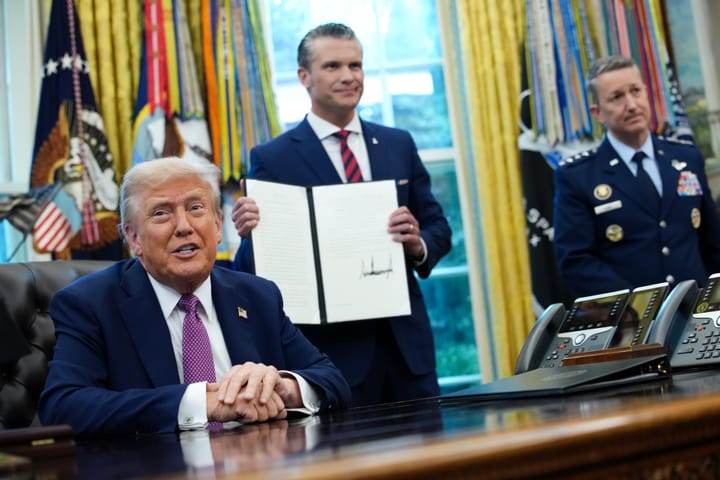With funding for nine Cabinet departments set to expire on Feb. 15, which would trigger another partial government shutdown, congressional Democrats have coalesced around an alternative to President Trump’s demand for a border wall: a surveillance wall comprised of radar-equipped drones, biometric data collection technology, and algorithmic risk assessment tools.
In a recent statement, Democratic appropriations leaders announced their support for “smart, effective border security” measures. Their proposal calls for “new cutting-edge technology along the border to improve situational awareness,” “new imaging technology at the land ports of entry,” “an expansion of [Customs and Border Patrol’s] air and marine operations along the border and in U.S. waters,” and “an expansion of risk-based targeting of passengers.”
Civil liberties advocates see the the Democrats’ proposal as an unwarranted intrusion on individual rights. “The House Democratic Conferees Proposal for Smart, Effective Border Security calls for funding various invasive surveillance technologies that would intrude on the liberties of travelers, immigrants, and people who live near the border,” wrote 27 tech and human rights groups, including ACLU, RAICES and Restore the Fourth, in a letter to House Democrats.
Several of the Democrats who have been touting increased border surveillance technology are top recipients of campaign donations from the defense companies that would likely receive contracts to build and maintain the systems, Sludge has found. These companies, which include Lockheed Martin, Northrop Grumman and General Dynamics, have been lobbying Congress on border technology appropriations for years, and they currently hold the largest border surveillance contracts with the Department of Homeland Security and U.S. Customs and Border Patrol.
Defense Industry Lobbying
Since 2014, Lockheed Martin has reported lobbying Congress on Department of Homeland Security (DHS) appropriations, including “issues related to U.S. Coast Guard long range surveillance aircraft and border security domain awareness technology.” In 2018, it lobbied the government on appropriations related to “Customs and Border Patrol border security and surveillance technology.”
Lockheed Martin is the recipient of the largest federal contract on record with DHS’s Customs and Border Protection Agency, according to usaspending.gov. Under the contract, which began in 2009, Lockheed Martin has earned nearly $690 million from U.S. Customs and Border Protection through maintenance and logistical support for its P-3 aircraft. The P-3 is described by CBP as a “high-endurance, all-weather, tactical turbo-prop aircraft primarily used to conduct long-range aerial patrols and surveillance missions along the U.S. borders and in drug transit zones in Central and South America.” Under another contract with CBP that ended in January, Lockheed Martin sold the government more than $4 million worth of surveillance and communications technologies to be used in Southeast Texas.
Defense giant Northrop Grumman also has large ongoing contracts with CBP, including one worth as much $344 million for development, maintenance, and enhancement of DHS’s Passenger Systems Program Directorate software. According to a job listing, Northrop Grumman is seeking to hire a senior biometrics engineer to work on the Passenger Systems Program Directorate software who has “experience designing and delivering facial biometric capture systems” as well as “experience assessing applicability of biometric modalities such as gait, iris at a distance, touchless fingerprint, or live video face capture.”
Northrop Grumman was also recently awarded a $95 million contract with DHS’s Office of Biometric Identity Management to work on development of the Heterogeneous Airborne Reconnaissance Team (HART) system, which is software that can integrate up to 50 manned or unmanned aircrafts or other systems to provide imagery and other related information. “The system can either dynamically retrieve, in near real time, the required information from a catalog of geo-registered images or direct manned/unmanned aircraft systems and/or sensors to collect updated intelligence, surveillance and reconnaissance information,” Northrop Grumman explains on its website.
General Dynamics has reported lobbying Congress consistently since 2011 on Department of Homeland Security appropriations including issues related to “information systems; telecommunications; technology equipment; infrastructure; support and services; border security technologies.” General Dynamic currently has a contract with Customs and Border Patrol worth up to $122 million to provide video surveillance upgrades. The contract involves the Remote Video Surveillance System (RVSS), an advanced wide-area electro-optical and infrared multi-sensor camera system that has been deployed at the southern border.
Donations from Surveillance Contractors
Several of the Democrats who have been pushing for a surveillance wall have received large contributions from companies such as Lockheed Martin and Northrop Grumman, and they’ve gotten a boost from a prominent centrist think tank and lobbying organization with ties to these companies.
The Bipartisan Policy Center, which describes itself as “a Washington, D.C.-based think tank that combines the best ideas from both parties to promote opportunity for all Americans,” has called for Congress to pass the Secure Miles with All Resources and Technology Act, or SMART Act.
The bill that would require DHS to deploy a range of technologies on the border for achieving situational awareness, including radar surveillance systems, sensors, unmanned cameras, and unmanned aerial vehicles. The bill specifically calls for the deployment of “Vehicle and Dismount Exploitation Radars (VADER),” a radar system developed by Northrop Grumman that can be attached to manned or unmanned aerial vehicles. In 2010, W. Richard Thissel of the Defense Department told the website Defense Systems that the VADER system feeds data to an onboard processor that uses “exploitation algorithms” to “detect, discriminate, and track vehicular and dismounted suspicious activity in near-real time.”
Texas Democrat Henry Cuellar, the lead Democratic sponsor of the SMART Act, has received $34,500 in campaign contributions from the PAC of Northrop Grumman, $40,000 from the PAC of Lockheed Martin and $16,000 from the PAC of General Dynamics since 2007. Cuellar was appointed by Democratic leadership to serve on the conference committee tasked with striking a deal on the border and other DHS funding issues to avert a shutdown.
In a recent post calling on the conference committee to strike a deal that includes new border security funding and a permanent solution for so-called DREAMers, the Bipartisan Policy Center described many of these same technologies as one of the key provisions that should be included. “Deploy region-specific technology to appropriate sectors of the southern border, including radars, acoustic detection and border tunneling technology, cameras additional unmanned aerial vehicles, sensor equipment and drones to improve situational awareness to detect and identify border incursions and deploy resources to intercept and interdict them,” the group wrote.
In its annual report for 2017, the most recent one available, the Bipartisan Policy Center disclosed receiving financial support from Northrop Grumman. They also disclosed receiving funding from Baker Donelson, a D.C. lobbying firm that represents Lockheed Martin, General Dynamics and other defense contractors. Former Lockheed Martin Chairman and CEO Norman Augustine is listed a member of the Bipartisan Policy Center’s Board of Directors.
House Appropriations Committee Chair Nita Lowey (D-N.Y.), a member of the conference committee and the Democrat who released the list of border surveillance proposals, has taken maximum donations of $10,000 from the PACs Lockheed Martin and Northrop Grumman in each of the last three election cycles. Since 2007, Lockheed Martin’s PAC has given Lowey $45,000 and Northrop Grumman’s has contributed $40,000.
House Whip James Clyburn (D-S.C.) has been one of the most vocal supporters of the Democrats’ surveillance wall plan. Clyburn recently told reporters that this wall, made of drones, scanners, and sensors, would “create a technological barrier too high to climb over, too wide to go around, and too deep to burrow under.” Since 2007, Clyburn has received $54,500 from the PAC of Northrop Grumman, $60,000 from the PAC of Lockheed Martin and $34,000 from the PAC of General Dynamics.
Rep. Pete Visclosky (D-Ind.), the top recipient of campaign donations from PACs and individuals affiliated with Lockheed Martin in the past election among House Democrats ($49,800), told constituents at a public forum recently that he supports a partial physical border wall supplemented by technology to cover the gaps. Visclosky has also received $59,000 from the PAC of General Dynamics and $48,500 from the PAC of Northrop Grumman since 2007.
The top Democratic recipient of 2018 cycle Lockheed Martin money in the Senate, Ben Cardin (D-Md.), wrote on Twitter that he thinks Democrats should get behind border technology as part of a compromise to keep the government funded. “Better technology? Absolutely. Let’s reopen the government and make that happen,” Cardin tweeted on Jan. 8.
House Speaker Nancy Pelosi (D-Ca.) has also been calling for more spending on border tech. “The positive, shall we say, almost technological wall that can be built is what we should be doing,” Pelosi said during a weekly press conference in early January. Since 2007. Pelosi has received $60,000 from Lockheed Martin’s PAC, $24,000 from Northrop Grumman’s PAC, and $10,000 from the PAC of General Dynamics.
Related:



